The Basics & The 3rd Card Rule
How to Deal Mini-Baccarat: Part 1
Table of Contents
How to Deal Mini-BaccaratFurther Reading
- Part 1: The Basics & The 3rd Card Rule
- Part 2: The Take-and-Pay Procedure, Ties & Commission
- Part 3: The Dragon Bet & Other Procedures
Did this free course help you?
Click to leave a tip to help keep this resource free!
Introduction
Before you begin learning how to deal baccarat; it is important that you know the basics of shuffling, delivering the cards from a shoe and dealing procedures.
Baccarat is played throughout many different countries around the world, and because of that there are several different versions. “Punto Banco” is the version of baccarat that is played in America, Canada, Australia, United Kingdom and Macau. “Punto” means “Player” and “Banco” means “Banker”. The dealer will notice this if their casino requires them to enter the hand into an electronic display because the player will be labeled as “Punto” and the banker will be labeled as “Banco”.
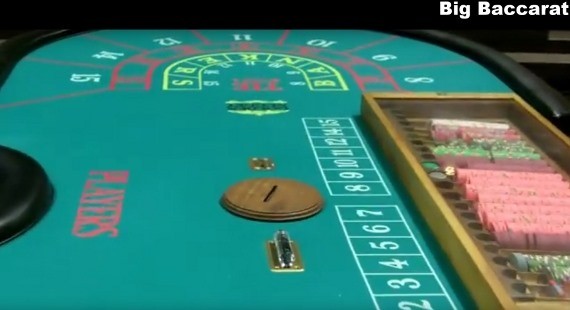
There are 3 types of baccarat: mini-baccarat, midi-baccarat and big baccarat. It’s good to learn how to deal mini-baccarat before learning how to deal midi-baccarat or big baccarat because mini-baccarat is the simple form of the other two.
Every table game in the casino has a built-in advantage that gives the casino their profit. The casino edge is usually measured in percentages.
The house advantage for baccarat is:
Banker – 1.17%
Player – 1.36%
Tie – 14.12% at a 8:1 payoff
Baccarat Table Layout
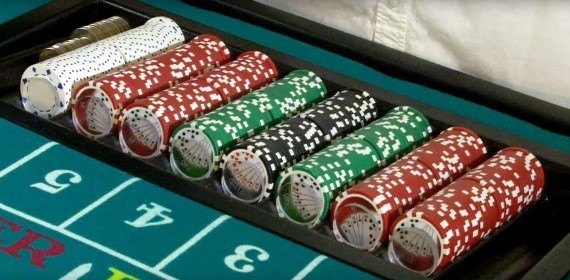
The bank is the rack of cheques in front of the dealer.
The long rectangle located next to the bank is called the commission box. You will see many boxes with numbers in them. Each number represents the spot where the player is sitting. Every time the player owes commission the dealer will mark it in this box until the time when the player pays it.
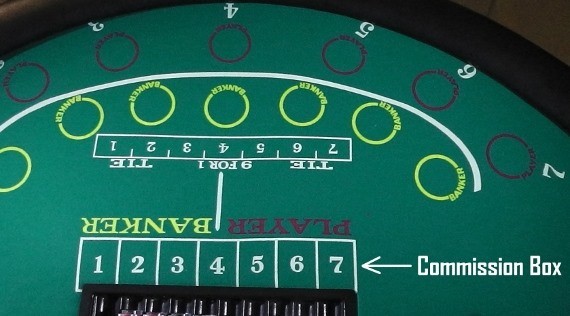
The shoe is located on the left side of the table. Usually the shoe will be 8 decks or higher.
There are 3 possible bets that the player can make. Player, Banker or Tie.
Most baccarat tables have their betting circles marked to correspond with the commission and the tie boxes. Now, because this game is extremely popular with people from China you will notice that their culture has inspired some changes in the layout. In China 4 is considered an unlucky number because it sounds similar to the word death, so most baccarat layouts are missing the #4 spot. This means that the numbered betting spots will go up to the number 8. And 8 is a very lucky number in the Chinese culture because it sounds similar to the words “prosper” or “wealth”.
The Basics
The object of the game is to bet on the hand that you think will receive the highest total value.
The dealer will deal 2 sets of 2 cards each. One set will go to the Player and the other set will go to the Banker. Each set of cards will be added up and the side with the highest total will win the hand.
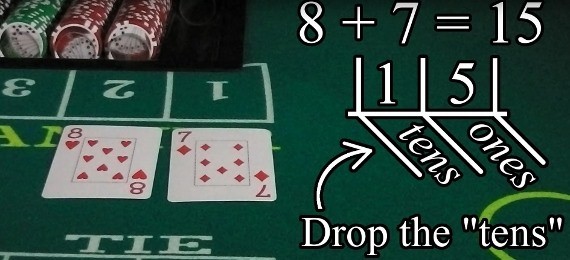
When you’re adding up the cards, the total must always be in single digits. For example, if your two cards are an 8 and a 7, then normally this would equal 15. But since single digits are the only valid total, it is customary to drop the “tens” place value. Drop the 1 and that the actual total is now 5. Because of this rule, all 10 value cards equal 0 and all Aces equal 1. This rule is applied to all place values. For example, if you draw two 10’s and a 5 then the total is 25; drop the two so your valid total is now 5.
3rd Card Rule
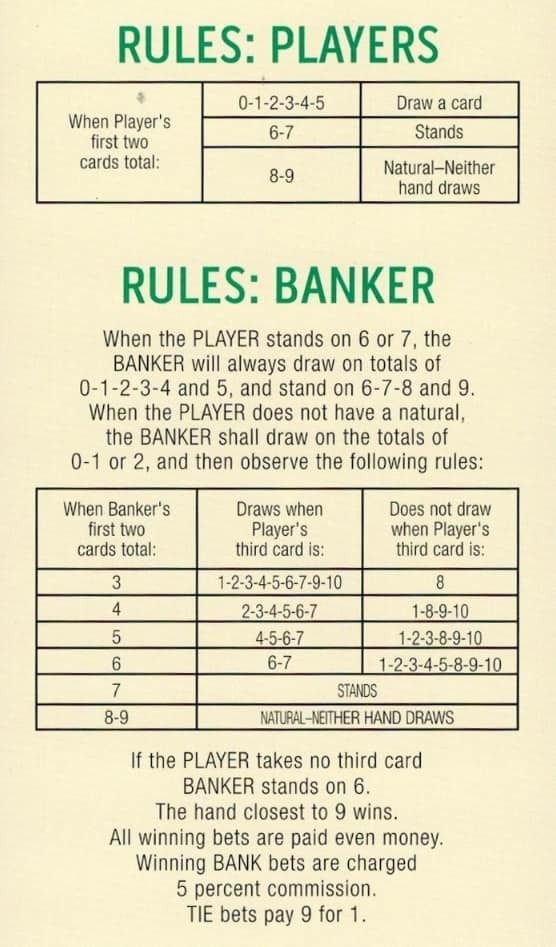
How do you know when it’s the right time to draw a 3rd card? Dealers must memorize a chart that is given to them by the casino. Most charts are the same but if a casino gives you a different chart to memorize you must follow your House rules.
-
If the Player’s 1st two cards equal 0 – 5, then the Player must draw a 3rd card.
-
If the Player’s 1st two cards equal 6 – 7, then the Player must Stand.
-
If the Player’s 1st two cards equal 8 – 9, then the Player has a “Natural” hand and no more cards are drawn. A “Natural” hand can only occur on the first two cards.
-
If the Banker’s 1st two cards equal 0 – 2, then the Banker must draw a 3rd card.
-
If the Banker’s 1st two cards equal a 3, then the Banker will always draw a card except if the Player’s 3rd card is an 8.
-
If the Banker’s 1st two cards equal a 4, then the Banker will only draw a 3rd card if the Player’s 3rd card is a 2 – 7.
-
If the Banker’s 1st two cards equal a 5, then the Banker will only draw a 3rd card if the Player’s 3rd card is a 4 – 7.
-
If the Banker’s 1st two cards equal a 6, then the Banker will only draw a 3rd card if the Player’s 3rd card is a 6 – 7.
-
If the Banker’s 1st two cards equal a 7, then the Banker must Stand.
-
If the Banker’s 1st two cards equal a 8 – 9, then the Banker has a “Natural” hand and no more cards are drawn. A “Natural” hand can only occur on the first two cards.
-
When the Player stands on 6 – 7, then the Banker will always draw a 3rd card if their 1st two cards equal a 0 – 5 and the Banker will always Stand on a 6 – 9.
-
If the Player takes no 3rd card, then the Banker will always Stand on a 6.
